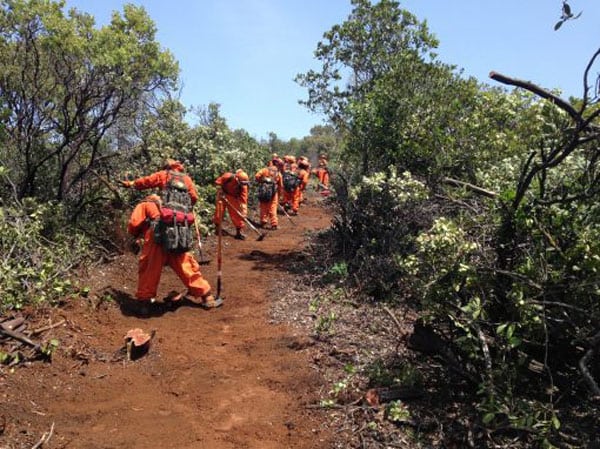
August 8, 2018; Atlanta Black Star
For 60 years, incarcerated people in California have been fighting the state’s wildfires for a pittance, even as the fires have grown larger and deadlier thanks to recent drought and climate change. The state’s attitude and statements about the program demonstrate a mindset that considers incarcerated people resources, at the service of California’s general population.
The Conservation Camp program is run jointly by the California Department of Corrections and Rehabilitation (CDCR) and the California Department of Forestry and Fire Protection (now known as Cal Fire). Forty-three camps dot the state, including three for women and one for juvenile offenders. Inmates are paid $2 per day, plus $1 for each hour spent on the front lines, which is nevertheless astonishingly considered high for prison wages. For each day of good behavior in the camps, workers get two days off their sentence. They also get better food, safety and physical fitness training, more relaxed family visits, and a chance to be outside in nature instead of behind prison walls.
The state of California gets an average of eight million hours per year of dangerous labor, for which they pay professional firefighters an average of $17/hour, virtually free. Four thousand inmates fight wildfires in California, making up about 30 percent of the force and reportedly saving the state about $100 million every year. (Never mind that the state has also estimated that it costs taxpayers nearly $71,000 a year to house and safeguard a single prisoner).
“The state of California is unabashed by that fact,” the director of Criminal Justice & Civil Liberties Policy at the conservative R Street Institute told Philip Wegmann of the Washington Examiner.
In fact, the state of California has fought to keep it that way. When the Supreme Court ordered California to reduce its prison population because of the terrible conditions created by overcrowding, state attorneys argued that “if forced to release these inmates early, prisons would lose an important labor pool.” According to Adam Serwer at Buzzfeed, “There is an exception…that allows the state to retain firefighters—but only firefighters—who are otherwise eligible for release.” (US Senator Kamala Harris, who was state attorney general at the time, was “shocked” to learn her staff had argued for this.)
The San Quentin News, a newspaper written, edited, and produced by residents of San Quentin prison, quoted Julie Hutchinson, a Cal Fire battalion chief, saying inmates are “very cost-effective” and “they’re out in the community, paying back for their mistakes.” Considering three inmates have died since 2012, it seems an awfully high price.
Other states also have prison firefighting programs, but California’s is the biggest. Moreover, though officials tout the training experience, it’s highly unlikely the inmates will ever be able to work as professional firefighters once they’re out; nearly all firefighting jobs require an EMT certification, and the training program doesn’t admit those with criminal records. (Some other states, like Arizona, do permit those released to go pro.)
Sign up for our free newsletters
Subscribe to NPQ's newsletters to have our top stories delivered directly to your inbox.
By signing up, you agree to our privacy policy and terms of use, and to receive messages from NPQ and our partners.
Prison officials defend the programs as beneficial to the inmates. Daniel Berlant, a spokesman for Cal Fire, said, “This is a reward for many of these individuals… They’re outside the walls, doing good work, learning a skill that they may not get behind bars.” Again, let’s remember, they’re learning a skill they will be unable to use because of the very circumstances that put them here in the first place.
California is benefitting from virtually free labor and touting it as a win for taxpayers. La’Sonya Edwards, an inmate in the program, says, “There are some days we are worn down to the core. And this isn’t that different from slave conditions. We need to get paid more for what we do.”
The SQN also quotes Bill Sessa, spokesman for CDCR, saying, “It’s difficult to call them enslaved when they’re volunteering to do the job.” But again, what are the real choices inmates face?
Advocates agree with Edwards. David Fathi, director of the ACLU’s National Prison Project, said his organization was concerned “that the desire for this cheap and powerless and literally captive labor force will distort decision making about the criminal-justice system…People should be incarcerated to protect public safety, not to provide cheap labor for either the government or for private employers.”
Jordan Barab, former OSHA deputy assistant secretary, said, “Anytime you see prisoners doing work, they don’t have the same kind of job security or right to complain about unsafe conditions. They can’t quit or go work for different jobs. They either do the job as they’re told to do it, or they go back to regular prison.”
Fathi agrees, saying, “In light of the vast power inequality between prisoners and those who employ them, there is a real potential for exploitation and abuse,” and “few things are clearly voluntary.”
California has been using the labor of incarcerated persons ever since men who were being held prisoners on a ship built the first state prison in 1853. Wages began to be paid in 1923, and the firefighting program started in the 1960s. This means the state has always counted on this nearly free labor in making its budget.
The rewards they say prisoners get—job training, decent food, and visits from family—should be part of California’s prison programs, not a perk of life-threatening work. Nicole Goodkind of Newsweek quotes Fathi when she points out, “If prisoners are being trusted to put out fires, save lives, and handle potentially dangerous weapons like axes and chainsaws with minimal oversight, ‘maybe they didn’t need to be in prison in the first place.’”—Erin Rubin













